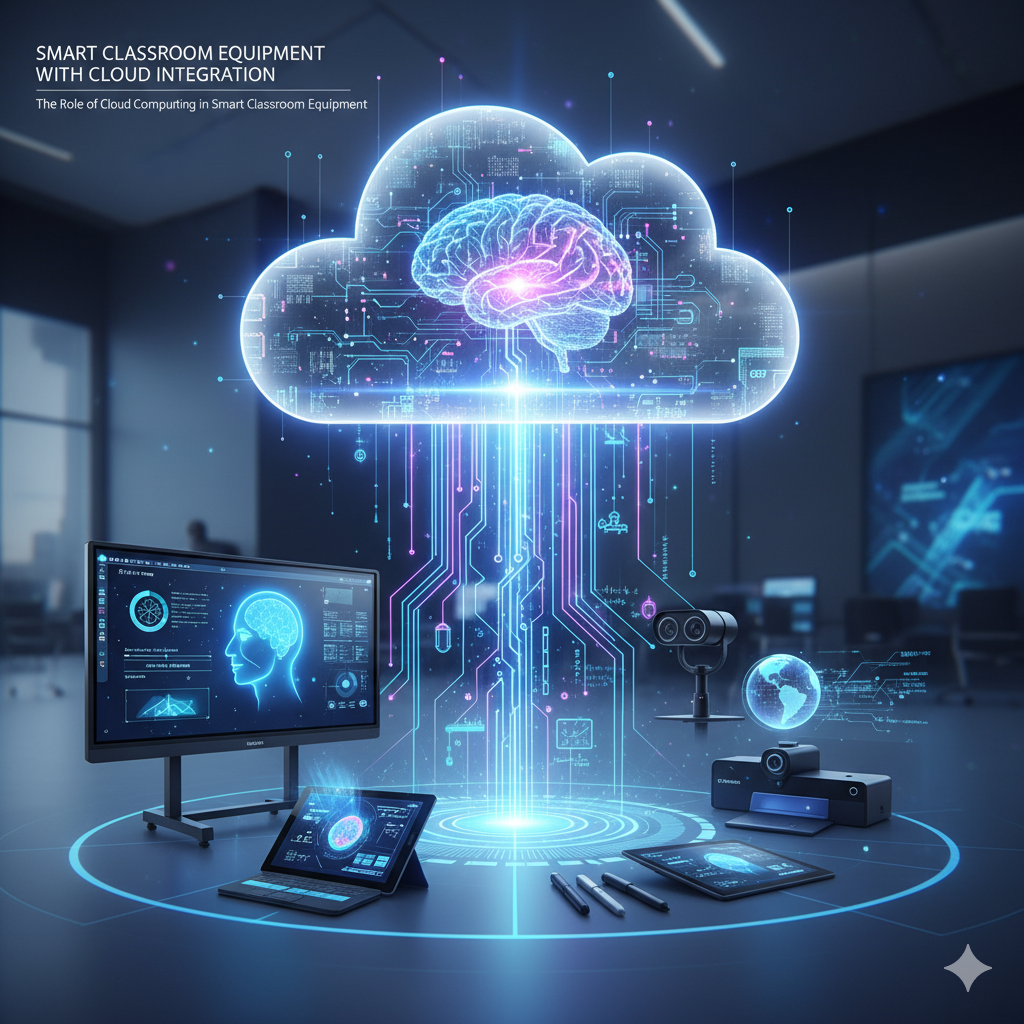The Role of Cloud Computing in Smart Classroom Equipment

Over the last decade, technology has quietly rewritten how teachers teach and students learn. Classrooms have moved beyond the four walls and chalkboards. Today, learning happens in real time, across screens, and often across cities and countries. At the center of this transformation sits a powerful combination: smart classroom equipment integrated with cloud computing. It is playing a key role in creating connected, intelligent, and inclusive classrooms.
Let’s understand how cloud computing is shaping the next generation of digital classrooms. What makes them so impactful? How can schools and colleges in India build future-ready smart classroom solutions around it? This blog discusses the answers to these questions.
What is Cloud Computing in Education
In simple terms, cloud computing means storing, managing, and accessing data or applications over the internet instead of a local computer or device. In education, this concept translates into giving teachers, students, and administrators access to shared resources. This includes lesson plans and assignments to recorded lectures, which can be accessed anytime, anywhere.
Instead of storing everything on a single smart board or laptop, cloud-based tools host teaching materials securely online. Teachers can upload lessons, record sessions, and share them instantly with students. Students, in turn, can log in from home, review notes, or rewatch a class at their own pace.
The beauty of this model lies in its simplicity. It removes hardware limitations and makes digital classroom setups more flexible and collaborative. Whether it’s a small school in a semi-urban area or a large university campus, cloud computing levels the playing field by making technology accessible and scalable.
How Cloud Computing Connects with Smart Classroom Equipment

Modern smart classroom equipment, such as interactive displays, projectors, dual cameras, visualizers, and digital writing tools, no longer operate as standalone devices. When connected to the cloud, these tools form an ecosystem that enhances how lessons are created, delivered, and stored.
Imagine a teacher using an interactive panel to explain a science concept. The entire session, including annotations and voice explanations, gets recorded and automatically stored on a secure cloud server. Students who missed the class can replay it later. Administrators can monitor usage patterns. Teachers can reuse the same material next semester without recreating it.
This integration turns every classroom interaction into reusable digital knowledge. As a result, fewer lost lessons, greater efficiency, and a continuous learning experience that extends beyond school hours.
For institutions, this also means lower maintenance. Instead of manually updating devices, software updates, and content synchronization happen through the cloud, keeping equipment ready and relevant with minimal IT effort.
Why Cloud-Enabled Smart Classroom Equipment Matters
Integrating cloud computing into classroom technology does more than simplify storage. It redefines how learning works. Below are key benefits that make cloud-based smart classroom solutions essential for modern education.
a. Centralized Access to Teaching Resources
Teachers can store presentations, videos, and lesson plans in one secure place and access them from any connected device. This eliminates dependency on USB drives or individual laptops. Schools can maintain a single, organized library of content, ensuring consistency across classrooms.
b. Seamless Collaboration and Engagement
Cloud platforms make it easier for students and teachers to collaborate on shared projects, quizzes, or whiteboards in real time. Whether it’s a hybrid session or a live classroom, interaction becomes continuous. Teachers can share assignments instantly, while students can respond through the same ecosystem.
c. Effortless Updates and Maintenance
Traditional classroom tech often requires manual updates or IT support. Cloud-based systems handle updates automatically. Institutions always have the latest software versions, new teaching tools, and enhanced security patches without downtime.
d. Scalability and Flexibility
Adding more classrooms or expanding across campuses doesn’t require new local infrastructure. With the cloud, scaling is as simple as updating your access plan. This is especially valuable for schools planning to expand digital learning initiatives under India’s NEP 2020 goals.
e. Data Backup and Security
Educational data like lesson archives, student work, or assessments is precious. Cloud platforms provide encrypted backups and version control, preventing accidental data loss. Teachers can retrieve older versions of files or restore deleted content in seconds.
f. Cost Efficiency in the Long Term
While adopting new technology requires an initial investment, cloud computing reduces ongoing expenses related to hardware upgrades, storage devices, and IT maintenance. Schools only pay for what they use and can easily scale down during non-academic periods.
How Cloud-Based Equipment Enhances the Learning Experience
The integration of smart devices with cloud platforms doesn’t just help teachers. It transforms the student experience as well.
- Personalized learning: Each student can access materials based on their pace and preference.
- Accessibility: Recorded lessons and online notes support students who miss classes or need revision.
- Inclusivity: Visual and audio content can be customized for different learning styles or needs.
- Continuity: Cloud access ensures learning doesn’t stop during holidays or disruptions.
For educators, the biggest change is visibility. Through data stored in the cloud, teachers can analyze engagement levels, identify which topics need more attention, and refine teaching strategies accordingly.
Common Challenges of Cloud Integration
Despite its advantages, cloud integration in digital classroom setups comes with practical challenges. Understanding them early helps institutions plan better.
a. Internet Dependence
Since cloud systems rely on connectivity, a weak internet can disrupt lessons. Schools can overcome this by choosing hybrid models where critical resources are stored locally but sync automatically when the network is restored.
b. Data Privacy Concerns
Institutions must ensure that their cloud service provider complies with security standards such as ISO or GDPR. Choosing systems that offer data encryption, user authentication, and local data hosting (especially within India) adds another layer of protection.
c. Training and Adaptation
Teachers and administrators need orientation sessions to get comfortable with new systems. Smart classroom equipment that offers simple, intuitive interfaces like plug-and-play setup eases the transition.
d. Integration with Legacy Tools
Older schools often have a mix of traditional projectors and newer interactive devices. Cloud-enabled platforms that support multiple input types make integration smoother without needing a complete infrastructure overhaul.
The Future: AI and Cloud Convergence in Smart Classrooms
The next phase of innovation lies in the fusion of AI and cloud computing. Artificial Intelligence is already enhancing smart classroom equipment, auto-recording lessons, summarizing content, and providing instant feedback.
When AI runs on cloud infrastructure, it can analyze massive datasets in real time. This includes tracking student engagement, evaluating performance trends, and even suggesting personalized learning paths. Teachers can view dashboards showing which parts of a lesson kept students most attentive.
Smart classroom equipment will soon come with edge AI capabilities, meaning the device itself can process information locally while syncing only essential data to the cloud. This reduces latency, improves security, and makes hybrid learning even smoother.
In India, as the education sector accelerates toward digital adoption under initiatives like Digital India and PM eVidya, this AI-cloud combination will play a critical role in bridging urban-rural learning gaps. It ensures every classroom, whether in a metro or a Tier-3 town, can offer a consistent digital experience.
How Schools Can Build a Cloud-Ready Digital Classroom Setup
Adopting cloud-powered classroom technology doesn’t have to be complex. Institutions can follow a structured approach:
- Assess the Current Infrastructure: Identify what equipment you already use—projectors, panels, internet bandwidth—and which tools need upgrades.
- Choose Scalable Smart Classroom Equipment: Opt for hardware that supports cloud connectivity, automatic updates, and content synchronization. Look for compatibility with common platforms like Google Workspace or Microsoft Teams.
- Implement Secure Cloud Services: Prioritize providers offering encrypted data transfer, access control, and backup solutions hosted in India for compliance and faster access.
- Train Faculty and Staff: Provide short workshops or demo sessions. The easier the tools feel, the faster teachers adopt them.
- Create a Hybrid Model: Combine online and offline functionality. Devices that record, store, and upload automatically, like Roombr’s interactive systems, ensure continuity even with intermittent connectivity.
By following these steps, institutions can gradually evolve their physical classrooms into smart, cloud-connected ecosystems without disrupting daily teaching schedules.
Key Takeaway
Cloud computing has shifted classroom technology from isolated devices to connected, intelligent ecosystems. It’s the invisible infrastructure powering collaboration, accessibility, and innovation.
For schools and colleges in India, integrating cloud-ready smart classroom equipment sets the foundation for long-term educational transformation. As learning becomes more hybrid, cloud technology ensures that every class, lesson, and idea remains available, shareable, and secure.
The future classroom is not just digital—it’s dynamic, adaptive, and always connected through the cloud.
Frequently Asked Questions (FAQs)
1. What is smart classroom equipment?
Smart classroom equipment includes interactive panels, digital boards, projectors, cameras, and content-sharing tools that enhance teaching and engagement through technology.
2. How does cloud computing improve classroom teaching?
Cloud computing enables teachers to store, share, and update teaching materials online, ensuring lessons are accessible anytime. It supports collaboration and reduces hardware dependency.
3. Can schools without strong internet connections use cloud-enabled smart classrooms?
Yes. Many modern systems offer hybrid modes. Content can be used offline and synced to the cloud automatically when internet access resumes.
4. Is data safe when stored in the cloud?
Leading cloud providers offer encrypted storage, multi-layer authentication, and compliance with global security standards. Choosing providers with regional data centers enhances security further.
5. What is the first step for schools planning a digital classroom setup?
Start by evaluating existing infrastructure and identifying cloud-compatible hardware. Gradual implementation with training helps achieve a smooth transition.
Looking to set up a digital classroom in your institution? Learn how Roombr’s smart classroom solutions make it easier.
Foziya Abuwala
Share
Step Into the future of
Education with Roombr

















